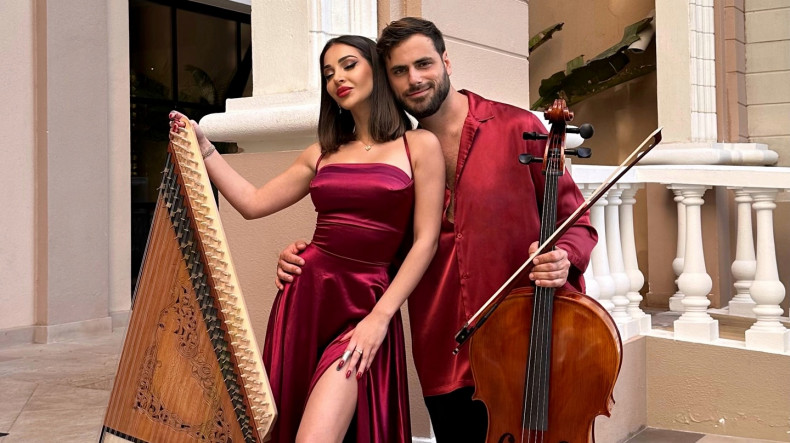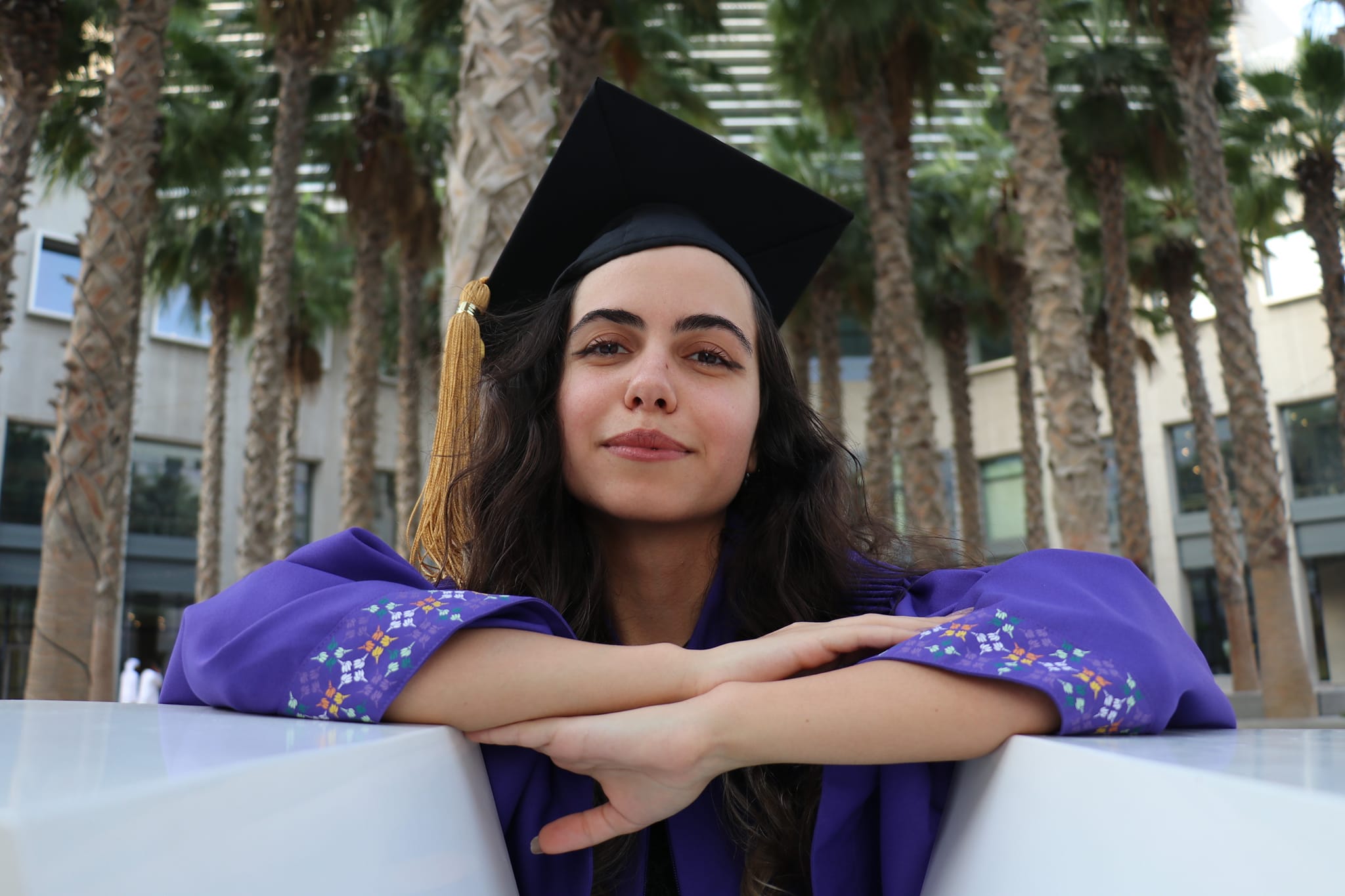Bella Papikyan is the first professional qanun player in the United Arab Emirates. However, this is not what she is famous for. What truly garnered attention to Papikyan as an artist and as a personality was her collaboration with world-renowned cellist Stjepan Hauser. Her duets with the world-class musician and magician of the cello sparked a wave of attention and admiration by millions of followers all across the web, moving audiences in Armenia, the UAE and across the world. I recently had the pleasure of interviewing Papikyan over email about her artistic journey, her widely-discussed collaboration with Hauser, her reception by the Armenian public and the prospects of qanun in contemporary music.
Milena Baghdasaryan (M.B.): What brought you to the world of qanun? What were your first steps?
Bella Papikyan (B.P.): I started my first steps in the music industry when I was six years old. My biggest inspiration was my father who plays the traditional instrument kamancha. He encouraged and inspired me to choose this very unique instrument.
M.B.: How did your collaboration with Stjepan Hauser start, and what was the inspiration behind your joint performances?
B.P.: A couple of years ago, during an interview, I was asked about the artist I would dream of performing with, and I mentioned Hauser. I am thrilled to share that my dream has since become a reality. I had the incredible opportunity to meet Hauser when he was in the UAE, and we collaborated for the first time. This experience was not only a significant milestone in my musical journey but also a testament to the power of pursuing one’s aspirations. The collaboration was a memorable fusion of our artistic visions, and I am grateful for the chance to work with such a talented musician.
M.B.: What motivated you to reach out to Hauser for collaboration, and how did you feel when he accepted your proposal?
B.P.: In every person’s life, there are inevitable ups and downs, and I experienced a period where I struggled with a lack of motivation and lost sight of my purpose. During this challenging time, I learned that Hauser was in Dubai, and I took the initiative to reach out to him to propose a collaboration. I was delighted when he quickly responded, expressing his interest in the idea. Our collaboration yielded remarkable results, as the video we created together has garnered over 27 million views on his Instagram account, making it the most-viewed post on his platform. This experience not only reignited my passion for music but also reaffirmed the importance of pursuing opportunities and connecting with fellow artists.

M.B.: Can you share some insights into the creative process behind your music videos with Hauser, particularly the “Love Story” series? In general (even when you’re performing alone), what does your creative process look like when selecting songs or compositions for your performances?
B.P.: The first piece we performed together was “Historia de Un Amor,” which translates to “Love Story” in Spanish. I suggested this particular song for our initial collaboration, and it proved to be a resounding success. Following this, we decided to embark on a series of “Love Stories,” many of which received fantastic feedback and garnered significant attention. In my solo performances, I gravitate towards romantic and evocative music that resonates deeply with me, as I believe that the music must first touch my heart before it can connect with my audience. I am highly selective and detail-oriented, striving for perfection in every aspect of my music videos, from my outfit to the chosen location. Once I have meticulously planned and visualized the project in my mind, and I feel confident in its potential for success, I proceed to record the audio.
M.B.: The reaction of the Armenian audience to your performances with Hauser is mostly positive, but there are inevitably negative comments too. How do you personally perceive and handle this criticism?
B.P.: In response to feedback on my music videos, I truly appreciate the positive comments, as they reflect the hard work and creativity that went into the project. At the same time, I recognize that not everyone will resonate with my work, and that’s a natural part of any artistic journey. Negative feedback can be challenging, but I view it as an opportunity for growth and learning. Ultimately, I understand that art is subjective, and while I strive to create content that connects with my audience, it’s impossible to please everyone.
My goal is to foster a dialogue between the past and the present, celebrating the cultural heritage while embracing innovation.
M.B.: As a musician with a background in both traditional Armenian music and contemporary styles, how do you blend these influences in your performances with the qanun?
B.P.: Blending traditional and contemporary styles in my performances is a dynamic and enriching process. When performing with my traditional instrument, I start by incorporating traditional techniques and motifs that pay homage to my roots. Then, I experiment with contemporary elements, such as modern rhythms, harmonies and electronic effects, to create a fresh and engaging experience. This fusion allows me to showcase the versatility of my instrument while also appealing to those who appreciate modern music. I believe that by bridging these two worlds, I can create a richer narrative and invite listeners to experience the beauty of both traditions. My goal is to foster a dialogue between the past and the present, celebrating the cultural heritage while embracing innovation.
M.B.: Could you describe some of the challenges you faced while mastering the qanun and how you overcame them?
B.P.: One of the primary challenges I faced was the complexity of traditional techniques, which required years of dedicated practice and patience. Initially, I struggled with achieving the precision needed for intricate passages, often feeling frustrated when my progress didn’t match my expectations. To overcome this, I adopted a structured practice routine that included breaking down difficult sections into manageable segments. I also sought guidance from experienced mentors who provided valuable insights and feedback, helping me refine my technique. Another challenge was balancing traditional styles with contemporary influences. It was important for me to stay true to my roots while also exploring modern expressions. To address this, I experimented with various genres, allowing myself the freedom to innovate without losing the essence of my instrument.
M.B.: What are some of your favorite compositions or musical pieces to perform on the qanun, and why are they special to you?
B.P.: Some of my favorite compositions come from the rich tapestry of Armenian traditional music, as well as timeless works by classical composers. Armenian traditional music holds a special place in my heart, because it connects me to my cultural heritage. One composer who particularly resonates with me is Komitas. His ability to preserve and elevate traditional Armenian traditional folk music is remarkable. One of the pieces is “Shushiki.” In addition to traditional music, I am profoundly inspired by the works of classical composers such as Bach, Chopin, modern composer Hans Zimmer, Ludovico Einaudi and many others. Together, these influences shape artistry, allowing me to draw upon the depth of my heritage while exploring the emotional landscapes crafted by classical composers. They remind me of the universal language of music and the connections we share through it.
M.B.: How do you see the role of the qanun evolving in contemporary music, both within Armenia and globally?
B.P.: The role of the qanun in contemporary music is evolving in exciting ways. Traditionally, the qanun has been a cornerstone of Armenian folk music, providing melodic and harmonic support in various ensembles. However, its unique sound and versatility are increasingly being embraced in modern musical contexts. Globally, the qanun is gaining recognition beyond Armenian music. Its distinctive timbre and playing techniques are being featured in world music, fusion and even film scores. Musicians from various backgrounds are discovering the instrument’s expressive capabilities and integrating it into their own works, enriching the global musical landscape.
M.B.: How has your Armenian heritage influenced your musical journey, and how do you incorporate elements of Armenian culture into your performances?
B.P.: Growing up surrounded by the sounds of traditional Armenian music, I developed a strong connection to my cultural roots, which informs my artistry and creative expression. Additionally, I strive to tell stories through my music that reflect Armenian history, folklore and experiences. This approach allows me to create a unique sound that resonates with both those familiar with Armenian music and those discovering it for the first time. Ultimately, my Armenian heritage is a source of pride and inspiration, guiding my musical path and allowing me to honor my roots while continually evolving as an artist.
M.B.: Can you tell us about any upcoming projects or collaborations you’re excited about?
B.P.: I have so many upcoming projects, which honestly I don’t want to talk about until they happen. Many concerts and collaborations are on their way to be delivered to my audience. Stay tuned!
M.B.: What advice would you give to aspiring musicians, particularly those interested in exploring traditional instruments like the qanun? What is the best advice you have ever received?
B.P.: To aspiring musicians, I would offer the following advice. Embrace your heritage; practice diligently; learn from the masters; experiment and innovate; collaborate with other musicians; share your journey; and stay true to yourself. By following these principles, aspiring musicians can not only enhance their skills with the qanun but also contribute to the preservation and evolution of traditional music.



Be the first to comment